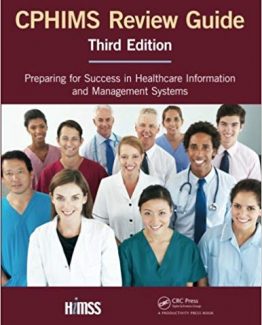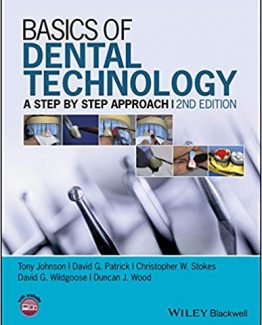The Evidence-Based Practitioner: Applying Research to Meet Client Needs 2nd Edition by Catana Brown, ISBN-13: 978-1719642811
[PDF eBook eTextbook]
- Publisher: F.A. Davis Company; Second edition (October 25, 2022)
- Language: English
- 336 pages
- ISBN-10: 1719642818
- ISBN-13: 978-1719642811
Put the evidence to work for your clients. Become an effective evidence-based practitioner.
Master the knowledge and clinical decision-making skills you need to provide the very best care for your clients…based on the evidence. Step by step, you’ll learn how to find, read, understand, critique, and apply research evidence in practice.
Five Stars! Great Book!“This is an exceptional book for not only OT students but other students in other health profession disciplines as well!”
- Updated! Current evidence and the policies and practices of occupational therapy today
- Expanded! Statistics coverage in three chapters: Descriptive Statistics: What They Tell You and How to Apply Them in Practice, Inferential Statistics: Tests of Difference, and Inferential Statistics for Relationship Questions
- New & Expanded! Qualitative research coverage in two chapters: Qualitative Designs: Exploring the Lived Experience and a new chapter, Trustworthiness of Qualitative Studies
- New! Introduction of the critically appraised paper (CAP) as a concept with a new feature that walks students through completing one
- Guiding principle of ‘Consuming vs. Conducting’ research
- How to write a research question that addresses a relevant practice problem and then how to find, read, and apply evidence to address the question
- Explanations of the different types of research and the methods and measurements used in each type, including their advantages and disadvantages.
- ‘From the Evidence,” excerpts with real data, abstracts, figures and tables from published research and coverage of how to decipher their meaning and apply them in practice
- “Evidence in the Real World,” personal narratives from health professionals who demonstrate using evidence in their practice
- “Understanding Statistics” boxes
- Worktext format with “Exercises” that encourage students to apply new concepts in the moment.
- “Review Questions” at the end of each chapter
- Answers to questions in the worktext at the end of each chapter
Table of Contents:
Cover
Title Page
Copyright Page
Dedication
Foreword to the First Edition
Preface
Acknowledgments
Reviewers
Contents in Brief
Contents
Chapter 1: Defining Evidence-Based Practice: Why Practitioners Need to Understand Research
What is Evidence-Based Practice?
External Scientific Evidence
Practitioner Experience
Client Situation and Values
Why Evidence-Based Practice?
The Process of Evidence-Based Practice
Formulate a Question Based on a Clinical Problem
Identify the Relevant Evidence
Evaluate the Evidence
Implement Useful Findings
Evaluate the Outcomes
Writing an Evidence-Based Question
Questions on Efficacy of an Intervention
Research Designs for Efficacy Questions and Levels of Evidence
Questions for Usefulness of an Assessment
Research Designs Used in Assessment Studies
Questions for Description of a Condition
Research Designs Used in Descriptive Studies
Questions for Prediction of an Outcome
Research Designs Used in Predictive Studies
Questions About the Client’s Lived Experience
Research Designs Addressing the Client’s Lived Experience
Critically Appraised Topics and Critically Appraised Papers
Review Questions
Answers
References
Chapter 2: Finding and Reading Evidence: The First Steps in Evidence-Based Practice
Identifying Databases
PubMed
Cumulative Index of Nursing and Allied Health Literature
Cochrane Database of Systematic Reviews
Employing Search Strategies
Selecting Key Words and Search Terms
Combining Terms and Using Advanced Search
Using Limits and Filters
Expanding Your Search
Accessing the Evidence
The Research Librarian
Professional Organizations
Determining the Credibility of A Source of Evidence
Web Sites
The Public Press and News Media
Clients’ Use of Evidence
Scholarly Publications
Impact Factor
The Peer-Review Process
Research Funding Bias
Publication Bias
Duplicate Publication
Distinguishing Scholarly Journals From Other Sources
Reading a Research Article
Title
Authorship
Abstract
Introduction
Methods
Results
Discussion
References
Acknowledgments
Review Questions
Answers
References
Chapter 3: Understanding Research Methods and Variables: A Foundation for Evaluating Research
Types of Research
Experimental Research
Nonexperimental Research
Quantitative Research
Qualitative Research
Cross-Sectional and Longitudinal Research
Basic and Applied Research
Hypothesis Testing: Type I and Type II Errors
Variables
Independent Variables
Dependent Variables
Control Variables
Extraneous Variables
Review Questions
Answers
References
Chapter 4: Descriptive Statistics: What They Tell You and How to Apply Them in Practice
Symbols Used with Statistics
Descriptive Statistics
Frequencies and Frequency Distributions
Measure of Central Tendency
Mode
Mean
Median
Measures of Variability
Normal and Skewed Distributions
Review Questions
Answers
References
Chapter 5: Inferential Statistics: Tests of Differences
Symbols Used with Statistics that Analyze Differences
Statistical Significance
Parametric Statistics to Analyze Differences
The t-Test
Analysis of Variance
One-Way ANOVA
Repeated Measures ANOVA
Mixed-Model ANOVA
Analysis of Covariance (ANCOVA)
Nonparametric Statistics for Analyzing Differences
Chi-Square
Mann-Whitney and Kruskal-Wallis Tests
Other Statistics That AID in the Interpretation of Difference Tests
Confidence Interval
Power
Review Questions
Answers
References
Chapter 6: Inferential Statistics for Analyzing Relationships
Research Designs And Symbols Used with Inferential Relationship statistics
Relationship Statistics for Continuous Data
Scatterplots for Graphing Relationships
Relationships Between Two Variables
Correlation Tables
Linear Regression
Relationship Statistics for Dichotomous Data
Odds Ratio
Risk Ratio
Hazards Ratio
Distinguishing Between Odds Ratios, Risk Ratios, and Hazards Ratios
Review Questions
Answers
References
Chapter 7: Evaluating Measurement Studies and Selecting Appropriate Tests Using the Evidence
Types of Scoring and Measures
Continuous Versus Discrete Data
Norm-Referenced Versus Criterion-Referenced Measures
Norm-Referenced Measures
Criterion-Referenced Measures
Test Reliability
Standardized Tests
Test-Retest Reliability
Inter-Rater Reliability
Internal Consistency
Test Validity
Construct Validity
Sensitivity and Specificity
Relationship Between Reliability and Validity
Responsiveness
Review Questions
Answers
References
Chapter 8: Choosing Interventions for Practice: Designs to Answer Efficacy Questions
Research Design Notation
Between- and within-Group Comparisons
Research Designs for Answering Efficacy Questions
Designs Without a Control Group
Randomized Controlled Trials
Crossover Designs
Nonrandomized Controlled Trials
Factorial Designs
Single-Subject Designs
Retrospective Intervention Studies
Sample Size and Intervention Research
Cost Effectiveness as an Outcome
Review Questions
Answers
References
Chapter 9: Descriptive and Predictive Research Designs: Understanding Conditions and Making Clinical Predictions
Descriptive Research for Understanding Conditions and Populations
Incidence and Prevalence Studies
Group Comparison Studies
Survey Research
Study Designs to Predict an Outcome
Predictive Studies Using Correlational Methods
Simple Prediction Between Two Variables
Multiple Predictors for a Single Outcome
Predictive Studies Using Group Comparison Methods
Case-Control Studies
Cohort Studies
Evaluating Descriptive and Predictive Studies
Levels of Evidence for Prognostic Studies
Review Questions
Answers
References
Chapter 10: Validity: What Makes a Quantitative Study Strong?
Validity
Statistical Conclusion Validity
Threats to Statistical Conclusion Validity
Fishing
Low Power
Internal Validity
Threats to Internal Validity
Assignment and Selection Threats
Maturation Threats
History Threats
Regression to the Mean Threats
Testing Threats
Instrumentation Threats
Experimenter and Participant Bias Threats
Attrition and Mortality Threats
External Validity
Threats to External Validity
Sampling Error
Ecological Validity Threats
Internal Versus External Validity
Using A Scale to Evaluate the Strength of A Study
Review Questions
Answers
References
Chapter 11: Qualitative Designs: Exploring the Lived Experience
Philosophy and Process
Philosophy
Research Questions
Selection of Participants and Settings
Methods of Data Collection
Data Analysis
Qualitative Research Designs
Phenomenology
Grounded Theory
Ethnography
Narrative
Participatory Research
Mixed-Methods Research
Finding Qualitative Research
Review Questions
Answers
References
Chapter 12: Trustworthiness of Qualitative Studies
Properties of Strong Qualitative Studies
Credibility
Prolonged Engagement
Interview Questions and Interviewing Skills
Triangulation
Member Checking
Transferability
Thick Description
Purposive Sampling
Dependability
Multiple Coders
Audit Trail
Confirmability
Saturation
Reflexivity
Matching Methods with the Purpose and Research Design
Review Questions
Answers
References
Chapter 13: Using Tools to Synthesize the Results of Multiple Studies: Systematic Reviews and Practice Guidelines
Systematic Reviews
Finding Systematic Reviews
Reading Systematic Reviews
Evaluating the Strength of Systematic Reviews
Replication
Publication Bias
Heterogeneity
Data Analysis in Systematic Reviews
Meta-analyses
Qualitative Thematic Synthesis
Practice Guidelines
Finding Practice Guidelines
Evaluating the Strength of Practice Guidelines
The Complexities of Applying and Using Systematic Reviews and Practice Guidelines
Review Questions
Answers
References
Chapter 14: Sharing Evidence With Clients, Families, and Colleagues
Client-Centered Practice
Shared Decision Making
Education and Communication
Components of the Process
People Involved
Engaging the Client in the Process
Consensus Building
Agreement
Decision Aids
Content
Resources for Shared Decision Making
Sharing Information with Colleagues
Journal Clubs
Communities of Practice
Review Questions
Answers
References
Appendix A: Critically Appraised Paper (CAP) Template
Glossary
Index
What makes us different?
• Instant Download
• Always Competitive Pricing
• 100% Privacy
• FREE Sample Available
• 24-7 LIVE Customer Support






Reviews
There are no reviews yet.